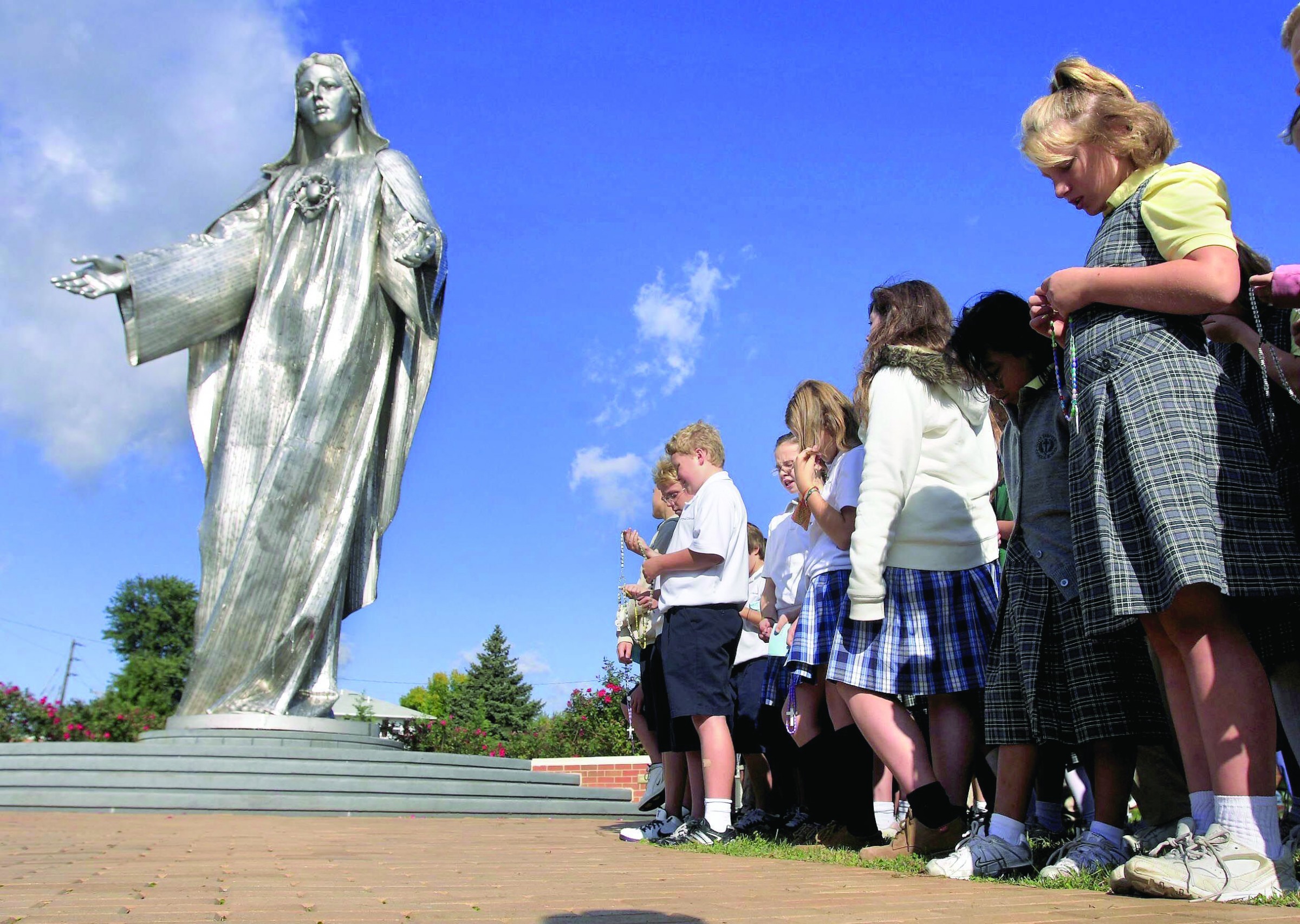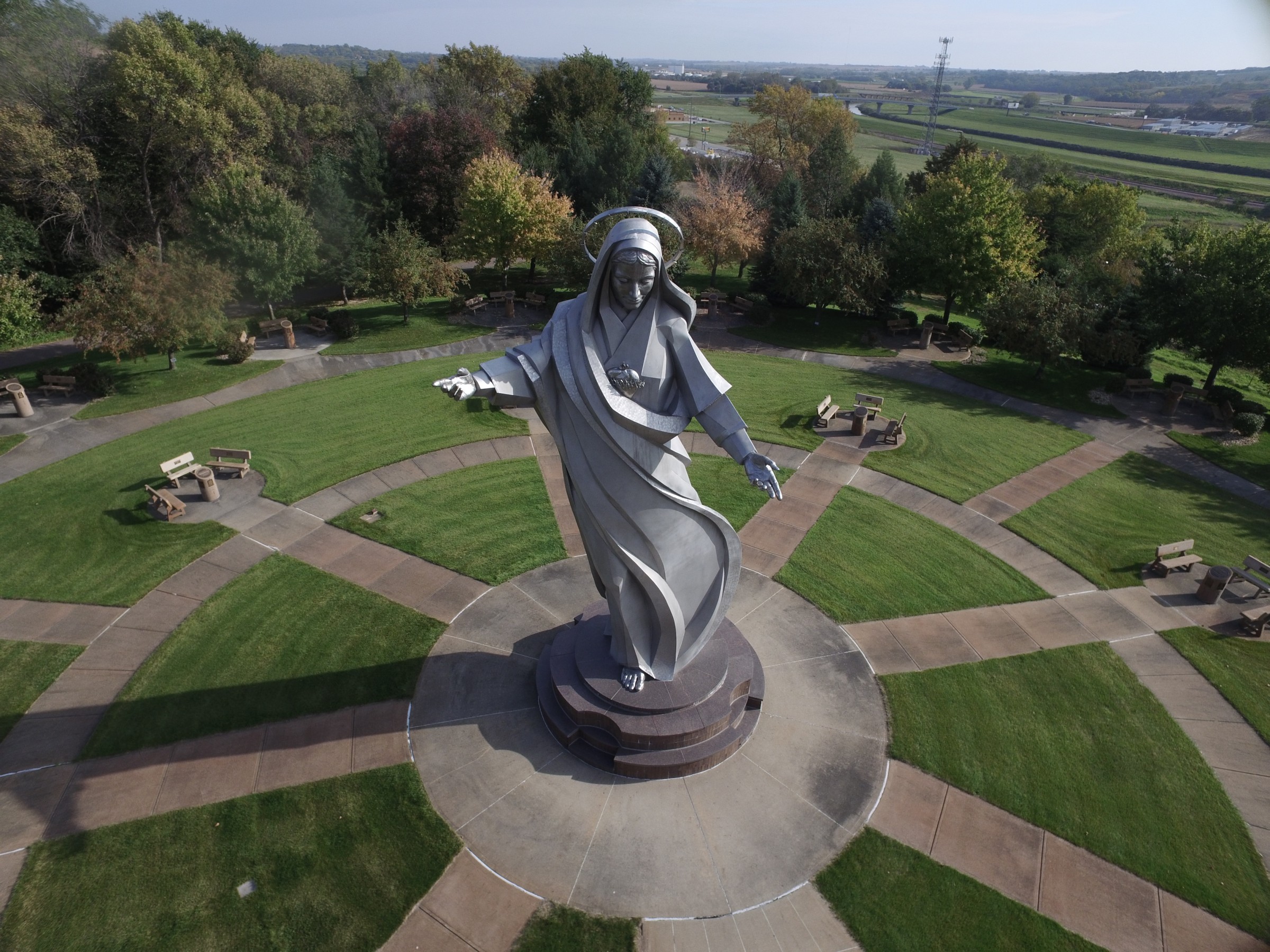Go to Mary, Along the Way: Marian Statues Invite Travelers to Stop and Pray
Reminders of the Blessed Mother along roadways.

Drive up California’s busy 101 freeway through the Diocese of San Jose and you’re likely to catch sight of an unusual but memorable expression of the Catholic faith: a 32-foot stainless steel statue of the Immaculate Heart of Mary located alongside the Church and Shrine of Our Lady of Peace in Santa Clara, California (OLOP-shrine.org).
This statue has been the inspiration of several other statues around the country — all inspired by the same love for Our Lady that first established this California expression of Marian devotion.
The Santa Clara statue was created and installed by Delaware sculptor Charles Parks (1922-2012) at the request of a former pastor, Msgr. John Sweeny (1924-2006). Today, it draws more than 1 million visitors annually and has prompted the creation of three other similar large statues across the United States.
In the aftermath of the Second Vatican Council (1962-65), Msgr. Sweeny “felt our culture needed a ‘forthright expression of faith’ to remind them of the heart of their Mother who yearned to draw them to her Son,” explained Rosemary Alva of San Jose, who attends the parish, leads tours of the shrine and is author of the new book Our Lady’s Way: Cultivating the Fruit of Peace (OurLadysWay.com). He wanted a statue that would say, “Peace in the world, and within yourself, is possible,” she continued, portraying a “mothering Madonna.”
“Why not put up a figure that nobody can turn down? Who can turn down the purest form of love that exists, the love of a mother for her children?” Alva asked. “How many times did we as children, before we were conscious of it, respond to the open arms of our mothers?”
When he first conceived of the idea, Silicon Valley had yet to be dominated by tech companies and expansive construction; the area around the parish included acres and acres of pear orchards.
As the area began to be built up, Msgr. Sweeny wanted a highly visible shrine to draw people, regardless of their faith. He said, “The world cannot benefit from a hidden faith, love or hope … We want to make her a statue of such splendid height that no one can ignore it, of a beauty that will attract and inspire all who see it, in the hope that many will respond to Our Lady’s invitation to love her Son.”
Parks was commissioned to create the image in his Wilmington, Delaware, studio, and it was shipped west and installed in Santa Clara in 1982. A blessing and dedication was held in 1983; Venerable Father Patrick Peyton (1909-92) delivered the homily. Father Peyton is the priest who founded the Family Rosary Crusade and coined the saying, “The family that prays together stays together.” His canonization cause is ongoing.
The statue is an invitation for those who pass by to stop and pray, Alva said, and to take advantage of the 24-hour-a-day adoration offered inside the church since 1976. Despite the many people who visit the site daily, Alva said, it is “remarkably quiet as a place to walk, reflect and pray.”
The parish has yielded a bumper crop of vocations, producing some 60 vocations to the priesthood and religious life in the past four decades, including the current associate pastor, Father Jonathan Dumlao.
Catholics of the Diocese of Wilmington, Delaware, who saw the creation of Santa Clara’s statue wanted Parks to create a similar Marian statue to remain in Wilmington.
A committee formed to get approval for and fund it, and it began its efforts by requesting 500,000 rosaries be said for a successful project. Bishop Michael Saltarelli (1932-2009) approved the project in 2000 and helped to raise the $500,000 needed for the statue by selling recordings of himself leading the Rosary and donating the proceeds to the statue fund. As a result, Parks created a 33-foot stainless-steel statute of Our Lady, Queen of Peace and installed it alongside Holy Spirit Church in New Castle, Delaware (HolySpiritChurchDE.org). It is visible to drivers who travel over the Delaware Memorial Bridge and Interstate 295. The bishop dedicated the statue in 2007.

Nearly 1,000 attended the dedication, during which Bishop Saltarelli acknowledged Mary’s role as our intercessor before God: “We pray for each other as wayfarers on earth. So why can’t we reach out to the Blessed Mother also to intercede for us?”
Two other large Marian statues have been inspired by Santa Clara’s Immaculate Heart of Mary. Oak Lawn, Illinois, resident Carl Demma (1932-2000), a liquor store owner and daily communicant with a fondness for large Catholic statues, commissioned Parks to create a 33-foot, stainless-steel image of Our Lady of the New Millennium in 1999.

He purchased a special truck with a hydraulic lift that he could use to bring the statue to different parishes in the Archdiocese of Chicago for celebrations; in 1999, he had it driven to St. Louis so that visiting Pope St. John Paul II could see it. After Demma’s death, the statue was installed in St. John the Evangelist parish in St. John, Indiana, and later at the Shrine of Christ’s Passion, also in St. John (online at ShrineofChristsPassion.org).
Father Harold Cooper (1924-2007) of the Diocese of Sioux City, Iowa, visited the Shrine of Our Lady of Peace and was inspired to return to his diocese to found Trinity Heights Shrine in Sioux City (TrinityHeights.com). One of its featured images is a 30-foot, stainless-steel sculpture of the Immaculate Heart of Mary, Queen of Peace opposite a 33-foot statue of the Sacred Heart of Jesus, both created by sculptor Dale Lamphere.

Alva concludes that the Marian monuments are “a constant reminder of Our Lady’s motherly love and heart and foster a devotion to her and the Rosary.”
Jim Graves writes from
Newport Beach, California.
- Keywords:
- marian shrines
















